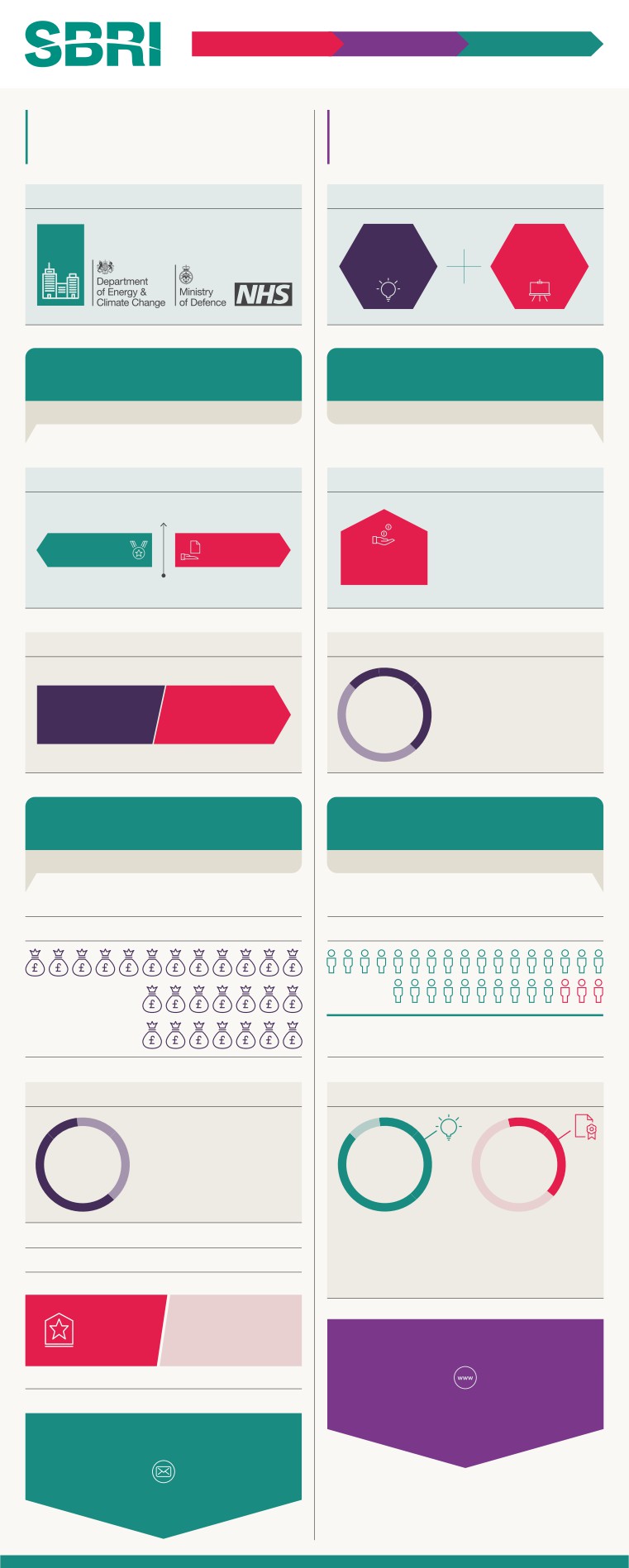New Anglia Innovation Board
Tuesday 24 September, 14:00-16:00,
The Ideas Factory, Norwich University of the Arts, Cavendish House,
28-32 St Andrews Street, Norwich, NR2 4AE
Agenda
1.
Welcome from the Chair: Introductions, apologies and minutes
14:00 - 14:10
Chair
a) Introducing Norwich University of the Arts
14:10 - 14:20
Sarah Steed
2.
Discussion Item: Climate Change
14:20 - 15:05
All
3.
Innovation Board Activity Plan:
15:05 - 15:40
Chair, Maddie, Julian
a) Governance Arrangements
b) Strategic Projects - Strengths in Places Fund
(Confidential)
c) Investment Paper: update paper
d) Innovation Forum - feedback and update paper
e) Innovation Prospectus
4.
Local Industrial Strategy - update
15:40 - 15:50
Maddie
6.
Innovation Board: Member update
15:50 - 16:00
All
-
Innovate UK
-
AOB
Invited:
David Carlin
Science Director
CEFAS
Madeleine Coupe
Innovation and Sector Manager
New Anglia LEP
Prof. Mohammed Dastbaz
Deputy Vice-Chancellor
University of Suffolk
Prof. Fiona Lettice
Pro-Vice Chancellor
UEA
Helen Lewis
Director of Research and Enterprise Division
UEA
Julian Munson
Head of Enterprise Zones and Innovation
New Anglia LEP
Vince Muspratt
Assistant Director, Growth & Development,
Norfolk County Council
David Parfrey
Executive Chair of Anglia Innovation Partnership
NRP LLP
Howard Partridge
Regional Manager
Innovate UK
Lisa Perkins
Managing Director, Research and Innovation
BT
Johnathan Reynolds (Chair)
Board Member
New Anglia LEP
Sarah Steed
Director of Innovation and Engagement
Norwich University of the Arts
David Tait
Chairman
Hethel Engineering Centre
Jack Weaver
Enterprise Zone Coordinator
New Anglia LEP
Guests:
Vimmi Hayes
Economic Development Manager
Rep. Orbis Energy
Prof. Andrew Lovett
Professor of Geography
UEA
Apologies:
Lisa Roberts
Head of Strategy
New Anglia LEP
Next Meeting: Tuesday 3 December, 14:00-16:00, University of Suffolk
New Anglia Innovation Board
Wednesday 22 May, 10:30-12:30
Keplar Room, Adastral Park, Martlesham Heath
Minutes
Attended:
David Carlin
Science Director
CEFAS
Madeleine Coupe
Innovation and Sector Manager
New Anglia LEP
Prof. Mohammed Dastbaz
Deputy Vice-Chancellor
University of Suffolk
Julian Munson
Head of Enterprise Zones and Innovation
New Anglia LEP
Howard Partridge
Regional Manager
Innovate UK
Lisa Perkins
Managing Director, Research and Innovation, BT
BT
Johnathan Reynolds
Board Member
New Anglia LEP
Prof. David Richardson (Chair)
Vice-Chancellor
UEA
Bradley Rowley
Innovation and Sector Development Coordinator
New Anglia LEP
Sarah Steed
Director of Innovation and Engagement
Norwich University of the Arts
Guests:
Vimmi Hayes
Economic Development Manager
Rep. Orbis Energy
Saffron Myhill-Hunt
Innovation Funding Manager
Invest East
Apologies:
Fiona Lettice
Pro-Vice Chancellor
UEA
Helen Lewis
Director of Research and Enterprise Division
UEA
David Parfrey
Executive Chair of Anglia Innovation Partnership
NRP LLP
David Taitt
Chairman, Hethel Innovation
Rep. Hethel Innovation
1.
Welcome from the Chair: Introductions, apologies and minutes
• David Richardson (Chair) welcomed everyone to the meeting and thanked BT for their hospitality.
• Apologies were noted. The background of the Innovation Board was provided for the benefit of the newest
members Norwich University of the Arts, University of Suffolk and CEFAS.
• Sarah Steed and Mohammed Dastbaz took a few moments to provide backgrounds on their respective
organisations. Each were invited to provide a more detailed outline during forthcoming Innovation Board
meetings;
Sarah Steed, Norwich University of the Arts (NUA);
NUA are renowned for their collaborations with businesses. They have recently developed a pilot that
facilitates a team of students and staff to assist business who have a specific issue that could benefit from a
new way of thinking.
The team at NUA also recently won the Employability and Entrepreneurship category at the prestigious
Guardian University Awards for their card and board game, called Profile. The game challenges students to
match real-world workplace issues to the skills and character attributes they need to resolve them.
On a personal note, Sarah also has other innovation experience gained from previous roles in the private
sector.
Mohammed Dastbaz, University of Suffolk;
University of Suffolk will be three years old in August. Over the three years, the university has seen rapid
growth; with an estimated 7000 students studying there by the end of 2019.
The university has introduced 20 new courses; mainly in STEM subjects. They work with a network of
colleges including East Coast College. They will shortly have a presence at Adastral Park through a
collaboration with BT (supported by New Anglia LEP)
Personally, Mohammed has an interest in sustainable development. He was previously a Professor of
Computer Science and conducted his PHD on the design of multimedia systems (before these were
developed and commonly used).
1a. CEFAS (New
Anglia LEP Innovatio
• David Carlin gave the attached presentation as a formal introduction to CEFAS.
• After three years as Chair of the Innovation Board, David Richardson took this opportunity to inform board
members of his intention to step down from the role. The current meeting would be his last. The Chair of the
Innovation Board will need to be an existing New Anglia LEP Board member and will be announced
following a decision at the New Anglia LEP Board meeting in June.
• The minutes of the previous meeting were agreed and accepted.
2.
Invest East
• Saffron Myhill-Hunt provided an outline of Invest East for those unfamiliar with the initiative;
Invest East is a free "investor led" programme to support Norfolk and Suffolk businesses to understand and
prepare to raise equity and other forms of finance.
They aim to provide a wide range of potentially high growth businesses with knowledge and the benefit of
others' experience to enable them to access the most appropriate type of funding for their needs. By
identifying strengths and weaknesses and optimising the investment proposal, they help those businesses to
put forward a compelling proposition to potential funders. Further information can be found at;
The first cohort of businesses have already been through a series of Investment Readiness workshops that
will culminate with a final event on 12 June when companies will have the opportunity to conduct their
pitches to the investment community.
The next cohort will commence in August, and the Invest East team will be looking to recruit companies
throughout June and July. There will be a greater emphasis to recruit companies from Ipswich and more
widely Suffolk as these were underrepresented in the previous cohort.
Action:
1.
All
companies who could benefit from the next Invest East cohort.
3.
Innovation Board workplan:
a) Innovation Board: Terms of reference
3a 2019-22-05
3a. Terms of
DRAFT Innovation B
Reference (Slides).pd
An overview of the attached paper and slide deck was provided.
During the previous Innovation Board meeting, it was outlined that the Terms of Reference would be
revisited to ensure these are robust enough to deliver the ongoing aims and future needs of the Innovation
Board.
There was a wide-ranging discussion surrounding the Terms of Reference and supporting slide deck.
Discussions points included;
-
In relation to Skills for Innovation; there was a consensus that delivery around this activity should not
replicate or overshadow the work being undertaken by the various skills boards.
-
The board should focus on innovation, and not science and innovation.
-
There was a suggestion that Cluster Development and Community Building could have a collaboration
focus and include reaching out to other LEP areas and could possibly include EU and international
entities.
-
A funding stream for innovation would be welcomed as high-risk activities often not supported
elsewhere.
-
A New Anglia LEP Innovation Strategy was recommended, where the LEP and Innovation Board was
responsible for driving innovation, and not just supporting it.
b) Activity Plan: Board Champions
3b 2019-19-02-
Board Champions.p
An overview of the attached paper was provided.
Innovation board members were asked to volunteer to champion one of the Activity Plan workstreams. As
there are more board members than workstreams, it was agreed that two board members could collaborate.
Champions would assist to drive the delivery of these activity streams within the Innovation Board and help
the LEP innovation team to shape future planning around these activities.
During the discussion, it was agreed that Cluster Development would be the next workstream to be
investigated at the next Innovation Board meeting in September. The following were agreed as champions;
Skills for Innovation - Mohammed Dastbaz and David Carlin
c) Investment in innovation
3c 2019-19-02-
3c. Investment in
Investment in Innov
Innovation (slides).p
An overview of the attached paper and slide deck was provided.
Following on from the conversation at the Innovation Board meeting in February, it was agreed that
Investment in Innovation would be the first workplan activity to be investigated.
As outlined during this session, actual innovation spend in Norfolk and Suffolk is difficult to evidence. This
stimulated further discussion around the table. The paper outlines some initiatives that could be progressed
to improve investment in innovation and facilitate collaborations. Both have been commonly identified as
required to stimulate additional innovation.
d) Innovation Forum & Ideas Foundation (LIS)
3d 2019-19-02-
Innovation Forum a
An overview of the attached paper was provided.
At the previous meeting, the Innovation Board endorsed the formation of the Innovation Forum. The
inaugural workshop is planned for Monday 17 June at John Innes Conference Centre and will be hosted by
Johnathan Reynolds. The theme of the first session will be Opportunities in Innovation, and links to the Local
Industrial Strategy (LIS) engagement activities. Invitations to around 120 individuals have been sent out,
with the expectation of around 40 individuals from various sectors, academia, and innovation focussed
organisations in attendance.
The workshop themes will provide feedback to shape the Ideas pillar of the LIS that directly relates to
innovation.
Action:
1.
Endorse revised Innovation Board Terms of Reference or recommend
Innovation Board members
amendments.
2.
Provide additional feedback of the workstream activity individuals wish to
Innovation Board members
volunteer to champion for future Innovation Board activity.
3.
Feedback additional comments and endorsement of investment propositions
Innovation Board members
outlined in the Investment in Innovation paper for LEP Executive to progress.
4.
Provide Innovation Board organisational representation at the Innovation Forum
Innovation Board members
(board member or additional representative)
5.
Provide feedback on Innovation Forum; Opportunities in Innovation workshop.
Bradley Rowley & Madeleine
Coupe
6.
Feedback future Innovation Forum workshop themes to be considered.
Innovation Board members
4.
New place branding: Update
• An update was provided on the new place branding for Norfolk and Suffolk. This remains confidential until it
launches on Friday 26 July, Adastral Park. The branding introductory video was played for those unfamiliar
with it. The branding has been designed in conjunction with Jacob Bailey.
A recent tender has been awarded to Quickfire Digital (Norfolk) and Land Communication (Suffolk) to
produce a new website and marketing collateral to promote Norfolk and Suffolk and facilitate investment into
the area. Land Communication have previous experience working with economic development agencies.
A brochure style website will be launched at the same time as the place branding, with additional website
functionality and campaigns implemented over the forthcoming months.
5.
Sector Industry Councils: New structures being implemented
Item 5. Industry
Council Structure.pd
An overview of the attached paper was provided.
Over the forthcoming months, New Anglia LEP will be implementing new industry councils for key sectors in
Norfolk and Suffolk; Agri-food, Digital/ ICT, and Energy. Each industry council will have a uniform structure.
This includes an innovation thematic/ task and finish group. Membership of these groups can come from the
main council, or external representatives (including companies). This would depend on the activity being
delivered. The innovation groups could lead to cross sector activity. They could also be utilised as an
additional link to the Innovation Board in the same way as the Innovation Forum.
All three industry councils should be implemented by the Autumn, with the Agri-food Industry Council being
the last to convene on Wednesday 17 September.
6.
Innovative Projects Fund & Growth Fund: Updates
6 2019-19-02
Innovative Projects a
An overview of the attached paper was provided.
There has been a significant focus on funding projects relating to digital innovation and skills.
In addition to the projects outlined, others have received conditional offers but have not been confirmed to
progress further at this stage.
A second wave of the Innovative Projects Fund is expected to be advertised in the next couple of months.
This initiative is funded through pooled business rates from Enterprise Zones. There are plans to include two
additional funding partners, and this is the reason for the delay in advertising the next wave. Should this
come to fruition, the funding available to projects would increase from £500,000 to £1.5 Million.
Action:
1.
Consideration to be given of potential projects that could apply for the
Innovation Board members
Innovative Project Fund. Madeleine Coupe and Bradley Rowley are available
to assist with the scoping of any project.
7.
Innovation Board: Member update
•
Hethel Innovation & Orbis Energy vacancies & Innovation Board representation;
Innovation Board members were informed that Simon Coward had stepped down from his role at Hethel
Innovation and will no longer attend board meetings. Norfolk County Council will recruit against the vacancy
in due course. In the interim, David Taitt will attend Innovation Board meetings.
•
Innovate UK
Howard Partridge confirmed that the next Innovate UK in the East of England event will take place on
Wednesday 4 March, Norwich Research Park
There are 15 competitions currently open, this includes the Innovate UK Smart Grant programme for April
(closes Wednesday 24 July).
Applications for the next round of Strength in Places funding will open on Monday 3 June, and close on
Wednesday 9 October. There will be £26 million allocated to deliver both round 1 and 2 projects. A series of
Strength in Places workshops are currently taking place, with a session confirmed for Peterborough on 23
May. Bradley Rowley confirmed that he will be attending this workshop.
New Anglia LEP have been invited to contribute to a round 1 Strength in Places Agri-tech project being
developed by Essex University. This is one of 23 projects that have received seed funding to develop their
project ahead of a final assessment. Bradley Rowley will attend a two-day workshop in Colchester on 30-31
May to assist with shaping the project further. In addition to New Anglia LEP, representation is expected
from business, sector organisations and academia from Essex, Cambridge, Hertfordshire, and Lincolnshire.
•
Personal statement from the Chair
Earlier in the meeting, David Richardson announced his intention to step down from chairing the Innovation
Board. The UEA will continue to be represented by Fiona Lettuce and Helen Lewis. David Richardson will
progress the UEA Office for Students; promoting internships and employability in the region, and the
Institute of Productivity.
•
AOB
There was no additional business raised by Innovation Board Members.
Next Meeting: Tuesday 24 September, 14:00-16:00, The Ideas Factory, Norwich University
of the Arts, Cavendish House, 28-32 St Andrews Street, Norwich, NR2 4AE
New Anglia Innovation Board
Tuesday 24 September, 14:00-16:00,
The Ideas Factory, Norwich University of the Arts, Cavendish House,
28-32 St Andrews Street, Norwich, NR2 4AE
Agenda Item 3.a
Governance Arrangements
Authors: Madeleine Coupe
Summary
This paper sets out the refreshed governance arrangements and activity plan for the New
Anglia Innovation Board following the endorsement of the Terms of Reference by the LEP
Board in June 2019.
Background
The Innovation Board was set up in 2015 to provide a focus for decision making and
leadership regarding innovation strategy, programme and project development. As an
important foundation of productivity, innovation is at the centre of the Government’s
Industrial Strategy and a key focus within the Economic Strategy and Local Industrial
Strategy. Given this increasing focus, in November 2018 the LEP Board endorsed the
continued role of the Innovation Board and approved a review into its Terms of Reference,
membership and outputs.
At their meeting in February 2019, the Innovation Board approved a new membership,
structure, purpose and set of workstreams. The Board’s Terms of Reference were
subsequently endorsed by the LEP Board at their meeting in June 2019.
At this meeting Professor David Richardson, who has chaired the Innovation Board since it
was formed in 2015 stepped down. The LEP Board nominated Johnathan Reynolds to
succeed as Chair of the Innovation Board.
LEP Assurance Framework
The New Anglia Local Enterprise Partnership governance arrangements are set out in its
Assurance Framework. The Framework outlines the processes and procedures for decision
making at New Anglia LEP. The document is an agreement between New Anglia LEP and
Government underlining the LEP’s commitment to transparency in decision making.
As a formal sub-board of the LEP, the Innovation Board must also adhere to LEP policies
relating to governance and transparency. The Assurance Framework is available to view
here.
Transparency
New Anglia LEP prides itself on transparency of decision making.
The LEP has a website which publishes information about its Board, Sub Boards and
Committees. This includes agendas, papers and minutes, membership details, Terms of
Reference and Registers of Interests of members. Agendas, papers and minutes published
on the LEP website will include all information appropriate for public disclosure, in line with
relevant local authority rules and regulations. The Innovation Board’s agendas, papers and
minutes are published on the LEP website here.
Conflicts of Interest
The Conflicts of Interest policy is on the LEP’s website and is also set out in the Articles of
Association. This sets out a clear process for dealing with any conflicts or potential conflicts of
interest that may arise. All LEP Board members, Sub-board members and staff are expected
to adhere to a Standards of Conduct Policy, which can be viewed here. Board members are
asked to read the Standards of Conduct Policy and note its contents.
The policy requires LEP board and sub-board members and leadership team to declare their
interests and any gifts or hospitality received in connection with their role in within the LEP. A
declaration of interest form and guidance will shortly be provided to Innovation Board members
for this purpose. Innovation Board members are asked to return the completed form once
circulated to be held by HR at New Anglia LEP.
Recommendations
The Board is invited to:
Note the contents of the report
Thank David for his contribution over the past 3 years
Welcome Johnathan Reynolds as the new Chair of the Innovation Board
Board members are asked to read the Standards of Conduct Policy and note its
contents.
Innovation Board members are asked to return the completed form once circulated to
be held by HR at New Anglia LEP.
New Anglia Innovation Board
Tuesday 24 September, 14:00-16:00,
The Ideas Factory, Norwich University of the Arts, Cavendish House,
28-32 St Andrews Street, Norwich, NR2 4AE
Agenda Item 3.c
Activity Plan: Investment in Innovation - update
Authors: Madeleine Coupe, Jason Middleton
Summary
At the last Innovation Board, a paper was presented which outlined proposals for activity
which supports the Investment in Innovation workstream. Since then, the Local Industrial
Strategy has been drafted which identifies additional interventions relevant to this
workstream.
This paper provides an update on progress against this workstream and aligns to the LIS
interventions.
Background
The Ideas Foundation of the LIS identifies that with partners, the LEP will:
Widen the cross section of businesses innovating and investing by providing the right
support and access to finance needed to increase productivity through innovation,
particularly focusing on clean growth.
Working with colleagues across the LEP Executive, a programme of activity is being
developed to stimulate greater levels of innovation. These will support and enhance the
Growth Programme, Innovation Forum and partner activity.
1. Develop an innovation supply chain and ‘ambassadors’
A database of companies has been developed, identifying businesses who have been
successful at securing Innovate UK funding.
This database will:
Expand the LEP’s knowledge about the innovation ecosystem
Enable the LEP and Growth Hub to target any interventions with the group of
businesses most likely to be successful.
Speed up the development of any LEP or partner funding bids in response to specific
calls, such as Industrial Strategy Challenge Fund
The next steps will be to develop a plan for engagement with the cohort with a view to creating
an ambassador network. The ambassador network will share best practice and examples of
success, as well as advocate for innovation.
2. Innovation, Research and Development Task and Finish Group
A sub-board of New Anglia LEP, the Business Growth Programme Partnership Board
(GPPD) brings together partners from across the business support landscape with members
such as MENTA, Growth Hub, UEA and Hethel. The BGPPB plays a key role in identifying
the needs of businesses and bringing partners together to develop joint solutions, to help
meet business needs. The Board also oversees the delivery of the Business Growth
Programme and acts as a sounding board on wider business support issues.
In order to fully integrate and align the work of the Innovation Board and the Business
Growth Programme, a proposal has been made to set up a task and finish group as a sub-
group of both the Innovation Board and the BGPPB. It will be facilitated by the Programmes
Team as part of the ERDF project and focus on delivery of the Innovation, Research and
Development Grant Scheme, mentoring support programme as well as identifying any gaps
in provision. The group will be made up of members such as Tech East, Hethel and EIRA
who have already expressed an interest.
The Innovation Board is asked to endorse the proposal to set up a Task and Finish
Group.
3. R&D Grants scheme
The New Anglia Innovation, Research and Development Grant Scheme (The Scheme) has
been developed in response to a lack of grant support to small and medium sized
businesses (SMEs) seeking to undertake research and development, the introduction of
new/innovative goods and services, and the implementation of innovative production and/or
delivery methods.
Grants between £1,000 and £25,000, at up to 50% of costs, will be awarded to 160 eligible
SMEs to enable them to invest in innovation, research and development.
The Scheme will directly de-risk SME investment in Innovation, Research and Development
by enabling SMEs to invest in new ways of working, introducing new products and innovative
services, and bring forward business growth and increase levels of productivity. This is in
line with the New Anglia LEP ESIF Strategy, Norfolk and Suffolk Economic Strategy and the
national Industrial Strategy.
Of the 160 grants awarded to SMEs, at least 35 of them will introduce new to the firm
product, 10 of them introduce new to the market product and 20 jobs will be created. This
will result in £4million of investment (£2million ERDF and £2million private sector) into
Innovation, Research and Development to foster higher levels of economic growth, increase
productivity and job creation.
Decisions on awarding grants will be taken by a grants panel in line with other grants
awards. The Innovation Board is invited to suggest names of anyone who might be
interested in being part of the decision-making panel.
4. Mentoring Support Programme
Public investment in R&D simulates private spending, but Norfolk and Suffolk are in the
lower percentile of LEP areas in accessing Innovate UK funding. A more proactive approach
needs to be taken to support businesses to access Innovate UK funding.
The Growth Hub has had some success running collaborative workshops with Enterprise
Europe Network (EEN) and Innovate UK, however businesses require more in-depth support
in order to take the ‘next step’ and bid for funding. One of the identified challenges for
Norfolk and Suffolk businesses is access to the technical skills necessary to be successful in
securing public investment in innovation. Due to the low number of businesses accessing
funding, there is a need to ‘upskill’ the innovation supply chain.
The Local Industrial Strategy highlights a key intervention aimed at addressing this
challenge:
Support business through a new voucher scheme for access to credible and high-quality
mentoring advice to support the development of bids for innovation funding.
New Anglia LEP is currently in discussion with EEN to set up a scheme through which
businesses can access mentoring advice in order to develop high quality Innovate UK bids.
The programme will use existing infrastructure such as the Growth Hub in order to reduce
the core costs of running.
Before commencing, a ‘bank’ of mentors will be recruited using a tendering process through
the Government’s Contracts Finder portal. Potential mentors will be screened using a
rigorous selection process to ensure credibility and expertise in the relevant areas with
advice taken from Innovate UK. Businesses will then be able to apply for support of up to
£2000 to access the mentor ‘bank’.
The proposal is being developed into a bid for New Anglia LEP’s Innovative Project Fund
(October call), and if successful will be launched in April 2020.
5. Small Business Research Institute (SBRI) event
SBRI is a programme delivered by Innovate UK which brings together government
challenges and ideas from business to create innovative solutions. A workshop which brings
together public sector colleagues across a range of services is being planned for Friday 20th
September in partnership with Norfolk County Council and Innovate UK.
Recognised by the Local Government Association (LGA) as a leading programme for
procurement, SBRI acts as a facilitator between public sector organisations and innovative
businesses.
SBRI works by providing new ventures and SMEs with contracts to develop innovative
products that address unmet public sector needs, offering a ‘win-win’ opportunity for both the
public sector and UK businesses alike. For the public sector, it offers a way to gain access to
new technologies, products and solutions to improve its cost effectiveness and address
policy challenges, whilst supporting a longer term, and more strategic, approach to
procurement more generally.
For UK businesses, it provides product development contracts from lead customers that are
focused on real market needs. It can provide 100% funding in amounts sufficient to have a
transformational impact on a company’s prospects at a point when other sources of funding
may be unavailable or insufficient.
A factsheet explaining more about SBRI is provided as appendix 3ci.
Next steps: discussions are taking place with Innovate UK about a potential follow-up event
aimed at businesses to raise the profile of SBRI opportunities. This may form part of a future
Innovation Forum which promotes a breadth of opportunities, including the mentoring
scheme, R&D grants and Innovate UK funding.
Recommendation
The Board is asked to:
Provide feedback on mentoring scheme and endorse the planned bid for Innovative
Projects Fund
Supply names of anyone who might be interested in being part of the decision-
making panel for the grants scheme.
Agree the proposal to use the Growth Programme R&D Task and Finish group as a
sub-group of the Innovation Board
GOVERNMENT CHALLENGES
IDEAS FROM BUSINESS
INNOVATIVE SOLUTIONS
Helping Government
Helping Business
SBRI helps government organisations solve
SBRI o ers innovators the chance to win a
tough challenges by connecting them with
government contract of £1m or more to help
innovative businesses.
demonstrate and develop their new technologies.
Solve problems
Get funding for new ideas
More than 80 public sector organisations have
already used SBRI successfully, including:
80+
£50-100k
£1.0m+
TO TEST AN IDEA
TO DEVELOP
A PROTOTYPE
“The real winners in this competition have been the
“The SBRI programme has been fantastic for us. It’s
patients. We know that we will save lives through
helped us move from an idea to a product that we know
these products.”
suits the need of the end user.”
Karen Livingstone, Director of Strategic Partnership, NHS East of England
Dan Hook, Managing Director of ASV
Access new ideas, suppliers and technologies
Increase sales
2017
360+ competitions
3,060+ contracts
Average annual sales
growth of more than 30%
30%
after taking part in SBRI.
2008
Save money and achieve objectives
Attract investment
For instance, SBRI could help the NHS…
More than half of
businesses find SBRI
£1.5bn
7.0m
50%
support makes it easier
NHS SAVINGS
PATIENTS HELPED
to get finance.
“Independent health economists predict that the
“It was a godsend to us. It finally meant that we were
Noctura 400 could save the NHS up to £1bn a year.”
taken seriously by the British MOD. We never would have
come into contact with government ministers otherwise.”
Richard Kirk, CEO, PolyPhotonix
Asha Peta Thompson, Co-owner of Intelligent Textiles Ltd
Drive the UK economy
Grow their business
10%
470m
More than £470m has
Jobs creation in companies that take part in
been invested in SBRI
SBRI is nearly 10% higher than average.
development contracts.
Support small businesses
Kickstart further innovation
go to SMEs
80%
30%
More than 80% of
A third of businesses
businesses find that
go on to create new
taking part in SBRI
intellectual property such
Encourage innovation
stimulates ideas for further
as patents, registered
innovation projects.
trademarks or copyright.
More than 50% of
businesses say taking
part in SBRI makes
50%
FIND DETAILS OF ALL CURRENT
them more likely to
innovate in the future.
COMPETITIONS AND APPLY ONLINE
FIND OUT HOW YOUR GOVERNMENT
ORGANISATION COULD BENEFIT FROM SBRI
New Anglia Innovation Board
Tuesday 24 September, 14:00-16:00,
The Ideas Factory, Norwich University of the Arts, Cavendish House,
28-32 St Andrews Street, Norwich, NR2 4AE
Agenda Item 3.d
Activity Plan: Innovation Forum - update
Authors: Madeleine Coupe
Summary
This paper provides an update on the first Innovation Forum which took place on 17 June at
John Innes Conference Centre.
The Innovation Forum supported the Ideas Foundation of the Local Industrial Strategy by
exploring the key issues and identifying opportunities relating to innovation in Norfolk and
Suffolk. It formed part of a wider programme of engagement for the LIS development.
Background
The development of an Innovation Forum has been agreed as a part of the Innovation
Board’s activity plan. The purpose of the Forum is to bring together regional partners to
discuss key issues and opportunities in order to help shape and inform the Innovation
Board’s activity.
It is an ongoing series of themed facilitated workshops that provide businesses and
innovation-focused organisations the voice to shape the future innovation priorities.
The first forum took place on 17 June, titled Opportunities in Innovation. With over 35 people
in attendance, the event focussed on the current innovation landscape and asked
participants to identify what is needed to unlock the region’s potential.
Workshop attendees were presented with the emerging evidence from the Local Industrial
Strategy and then asked to identify the top three actions that wold achieve the largest impact
to the following questions:
1. How can we improve the amount of investment in innovation and the number of
companies innovating?
2. How can Norfolk and Suffolk be recognised as an area for excellence and meet
global challenges? In terms of creating value through innovation - what could we be
credibly known for?
3. What is needed to create the conditions for greater levels of innovation and
collaboration?
4. What is required in Norfolk and Suffolk (finance, networks, spaces / hubs, support
programmes) to encourage innovation and collaboration?
Full feedback is presented in appendix 3.c.i, but the main themes that emerged are
summarised here:
-
Promotion of the region: recognise and celebrate innovation through case studies
and awards.
-
Collaboration:
Develop an open innovation forum to focus on knowledge exchange across
sectors, and to build capacity to bid for Innovate UK funds as a consortium.
Work with universities and research institutes to facilitate greater levels of
engagement between research and industry
-
Spaces: scale up and link offer at innovation centres and hubs offering a central
service with access to funding, support programmes, access to (academic and
business) collaborations and (global) networks.
-
Access to finance: extend the support at the Growth Hub to offer easier access to all
the available support.
Future Innovation Forums
The first Innovation Forum was successful in providing feedback for the development of the
Local Industrial Strategy. However, thought should be given on how the brand and reach of
the Innovation Forum can be extended to engage with a broader selection of stakeholders.
Future events can be used to extend the brand of the Innovation Forum, such as:
-
Dinner at Innovate UK conference: plans are being developed to host an event at the
Innovate UK Conference at Norwich Research park (4th March 2020). Engaging with
key stakeholders, either dinner or a breakfast networking event could be included as a
part of the Innovation Forum brand.
-
Open Innovation Forum: a further Innovation Forum needs to be planned for Spring
2020. A possible theme could be business support for innovation with presentations
from a variety of organisations including Enterprise Europe Network (EEN). The
workshop would also be a good opportunity to promote the new R&D grants and
innovation mentoring scheme (outlined in paper 3d). Lessons from the first workshop
include:
Agenda and ‘keynote’ speaker promoted early to allow delegates to note if it is
relevant to them
Use media channels and partner networks to promote as an ‘open’ invitation list
Recommendation
The Board is asked to:
Note the contents of the paper
Provide any feedback or ideas on developing the Innovation Forum
Monday 17 June 2019
John Innes Conference Centre, Norwich Research Park, Norwich, NR4 7UH
Feedback
Table 1
Table 2
Jon Carter
UEA
James Allen
New Anglia LEP
Nigel Cornwall
New Anglia Energy
Callum Coombes
Safepoint
Maddie Coupe
New Anglia LEP
Michael Davey
Connecting Norfolk
Samuel Cox
KLM UK Engineering Ltd
Nova Fairbank
Norfolk Chamber of Commerce
Julian Munson
New Anglia LEP
Matthew Poll
Anglia Innovation Partnership LLP
Johnathan Reynolds
New Anglia LEP
Lisa Roberts
New Anglia LEP
Rajinder Sharma
Connected Places Catapult
Richard Seager
Thurne-Middleby Ltd
David Taitt
Hethel Innovation
Matt Skipper
Mills & Reeve
Table 3
Table 4
Mark Brenner
Aurex International
John Allen
Aviation Skills Partnership
Eliska Cheeseman
Norfolk County Council
Gary Chalkley
Camvac Ltd
Ben Evans
Vision Assets
Linn Clabburn
New Anglia LEP
Tim Robinson
Tech East
Danielle Jackson
Metro Dynamics
Bradley Rowley
New Anglia LEP
Kenny Lang
UEA/ EIRA
Pandora Tucker
BDO
Julie Pauley
Enterprise Europe Network
Patrick White
Metro Dynamics
Alice Reeve
Hethel Innovation
Robert Smith
Invest East
Investment in Innovation
1. How can we improve the amount of investment in innovation and the number of companies innovating?
2. What are the top three actions you think are required that would achieve the largest impact?
3. How could these be delivered?
Table 1
1. Innovate UK: devolve resources to the regions and introduce regional engagement
programmes
Delivered through a LEP pilot.
2. Open innovation forum to focus on knowledge exchange across sectors. Dissemination and
sharing success. Build capacity to bid for Innovate UK funds as a consortium.
3. Engagement - demonstrate why innovation and investment are important and why
businesses should invest. Engage more with innovations closer to the market that will see a
greater share on investment. Share successes.
4. Clustering - to increase collaboration, critical mass, and reduce capital costs. Clustering will
support network sector groups, assist to understand different clusters and needs, and aid
knowledge and success sharing.
Table 2
1. Assistance with grants processes and schemes that exist.
2. More co-investment funding will drive private sector investment.
3. Innovation awards would drive more businesses to innovate.
Table 3
1. Innovation awards - recognise innovation (sector specific), provide examples of innovation
and best practice/ case studies. Marketing campaign to promote innovation.
2. Innovation networks - connect collaborative sector networks (creating networks where none
exist). Assist companies to find like minded ‘tribes’ and networks to suit their needs. Use
Cambridge Norwich Tech Corridor as a network and not just about the physical space.
3. Investigate why companies do not innovate. Survey?
Table 4
1. Promotion and de-mystifying of funding opportunities and tax credits to fund innovation.
Delivered through Growth Hub and accountants in the region.
2. Connecting existing support groups and networks to support innovation from idea through to
business.
Delivered through dedicated account managers
3. Promotion: centralised forum to share and celebrate innovation successes to attract skills
and create and environment of innovation.
Additional
1. Visibility of knowledge transfer agreements and opportunities.
notes
2. Innovate UK funding focussed on large companies and not SMEs.
3. Ensure companies are aware of Innovate UK funding and family of support to assist
commercialisation funding.
4. Connect local and international companies and communities. Identify gaps.
5. Better use of trade organisations.
6. Remove educational agendas
7. List contacts and bodies on one portal (Innovation Forum site?) for ease of access and to
guide funding support to materialise R&D development
8. Tax credits for innovation funding available but not accessible
9. Exploit EIS (Enterprise Investment Scheme) and SEIS (Seed Enterprise Investment
Scheme) alongside R&D Tax Credits
Themes
1. Innovation awards and success sharing
2. Innovation support network: promotion of knowledge, funding, capacity building for consortiums.
3. Increase access to Innovate UK funding
Developing Innovation
1. How can Norfolk and Suffolk be recognised as an area for excellence, and meet global challenges? In
terms of creating value through innovation - what could we be credibly known for?
2. What are the top three actions you think are required that would achieve the largest impact?
3. How could these be delivered?
Table 1
1. Blue Tech - Maritime economy (Port of Felixstowe)/ Blue economy pathfinder. Link coast to
inshore/ offshore; autonomous shipping, logistics. Energy, visitor economy. Northern
economies dependent on us.
2. Decarbonisation - focus on decarbonisation in all sectors. Biggest emitters are also the
biggest growth areas.
3. Convergence of tech (testbed); maritime, rural, aging population, location (access to
London), sustainable housing. All components for testbed for new technology. Healthy
Ageing Testbed (with UEA); Demographics of Norfolk and Suffolk to enable this. New
products and services could lead to business opportunities, health date and third sector
opportunities.
Table 2
1. Embed business in the curriculum and not just for career talks
2. Lead in next generation broadband and 5G so Norfolk and Suffolk is the go-to place.
3. Perception of the region needs to improve - standard cost of life, travel times, investment
gong on in the region. Communication and local aspiration need to improve.
4. Need leadership and strategy to bring together all of the great pockets of activity that is
going on in Norfolk and Suffolk
5. There is nowhere else in the UK that does what Norwich Research Park does. Nowhere
else in the UK that has an all-energy proposition like we do. MPs, Councils, LEP, Schools.
Etc all need to buy-in.
Table 3
1. The UEA is a centre of excellence, and a pioneer. Why is this not celebrated more in the
regional and national news. There is a need to link and promote academic hubs.
2. Make more use of innovation assets. Remove artificial LEP area barriers. Work more
collaboratively with other LEPs to promote opportunities.
3. Focus investment and resources on where there is a match between market and
excellence. Innovation benefits could result in a spill over effect on other businesses
(collaborators-investment-capability).
Table 4
1. An opportunity to make us important on a global agenda - UN sustainable development
goals by benchmarking the region on power and food. Provide a trusted voice internationally
(sustainability awards). Global twinning.
2. Show that we ‘put our money where our mouth is’ by delivering short term wins from the
science and innovation audit.
3. A large future opportunity is energy. The supply chain provides opportunities for supply
delivery.
Additional
1. Known for; ports tech, insure tech, clean energy tech, agri-tech, health tech (specialising in
notes
medicine)
2. Known for; offshore wind (integration of energy storage and power transmission/
distribution), food science, crop resistance (plant health/ ecology)
3. Home for sustainable living; transport, developments, circular economy, and culture. All part
of the UN sustainability goals.
4. Environmental innovation cluster; underpinned by digital strengths. Clean/ renewable
energy, productive agriculture, healthy living, low carbon future transport solutions,
opportunity to live well and grow careers.
5. We have an amazing opportunity to define our growth; Greater Norwich local plan, garden
villages, futuristic transport links, SETI.
6. Sustainability aligns to popular trends and latest UK Government goals. This will attract
talent. The day of high wages and big city living being cool are gone. Having a career with
positive impact at a sustainable business in a location which is clean, and green is in.
7. Great opportunity not to dump science/ tech parks into existing infrastructure and build cities
or innovation districts properly.
8. Our research/ academic USP could be business engagement and commercialisation. UEA
engineering won’t lead against other great engineering universities but could lead in
business engagement in research and local impact within engineering-based projects.
Themes
1. Promote and make more use of the innovation assets in Norfolk and Suffolk (UEA, Norwich Research Park,
Energy sector). Obtain ‘buy-in’ from MPs and others.
2. Become a test bed for innovation around energy or ageing population to promote recognition of Norfolk and
Suffolk on an international stage.
Engaging Innovation Networks and Collaborations
1. What is needed to create the conditions for greater levels of innovation and collaboration;
A) Locally
B) Nationally
C) Internationally
D) To facilitate more value creation between business and academia
2. What are the top three actions you think are required that would achieve the largest impact?
3. How could these be delivered?
Table 1
1. Open innovation model; challenges between businesses and Higher Education. Encourage
more links between the two.
2. Research to revenue; skills and ambition, investment, and space are all required to take
them from research to revenue.
3. Clustering/ physical spaces; IP from UEA needs further development at early stages. There
is a need for physical spaces for spinouts. Additional programmes like the Bright Stars are
required. Encourage more relationships between existing hubs including Hethel Innovation
& UEA, and Orbis Energy & UEA.
4. Innovation Forum; this could be developed to agree research priorities for the region and
joined up with investment bodies such as Research Council and Innovate UK.
Table 2
1. EIRA - encouraging businesses to work with academia. Safepoint had a graduate through
EIRA. They made a huge difference. Gives graduate relevant skills they want and need.
2. Do your engineer funding; so, 70% research and 30% commercialisation for example
working with business.
3. Very few examples in the UK of businesses working with academia. A lot of businesses
would go to relevant sector specific consultants with business awareness.
4. Research papers are important for universities and for attracting new students. They do not
want these published if a business is working with them.
5. Service industry is perhaps not as expensive to work with academics as manufacturing.
6. Norwich Business School is very proactive but greater integration with the rest of the UEA
would make it stronger.
7. Need universities to work together and not compete to tackle challenges that are set by
businesses.
Table 3
1. Expand EIRA to include other sectors; Agri-tech, Energy, Manufacturing, Logistics,
Financial Services.
2. Increase incubation opportunities for spinouts. Universities and LEP should be responsible
for incubator recognition. Recognise the 1/10 of start-ups that are still going to change
culture and make ambition more common.
3. Either incentivise universities to work with local businesses or support businesses to
demonstrate demand to universities.
4. Lobby UKRI/ Innovate UK to facilitate business and university collaborations by adapting
eligibility of some funding competitions (like recent requirement for business to work with
NHS).
5. Barrier to knowledge sharing/ research with universities and businesses is commerciality.
Fear that any IP generated will become public and then any commercial benefit lost.
6. Development of innovation culture should come via education.
Table 4
1. Universities are stretched in terms of doing research. Much time is spent teaching.
Universities such as UEA need a new model for balancing research and teaching.
2. We might need a regional lower knowledge exchange network to match industry with
academia.
3. One centre of excellence for innovation, incubation and research to focus on applied work -
focus on the main sectors (Uppsala Bio - model). Open innovation model.
4. Early stage discussion about IP. Universities need realistic expectations.
Additional
None
notes
Themes
1. Expansion of EIRA to support alternative sectors.
2. Work with universities to facilitate/ incentivise further engagement with businesses and sector focussed
organisations.
Innovation Environment
1. What is required in Norfolk and Suffolk (finance, networks, spaces / hubs, support programmes) to
encourage innovation and collaboration?
2. What are the top three actions you think are required that would achieve the largest impact?
3. How could these be delivered?
Table 1
1. Join up expertise between innovation and hubs - offer consistent level of support. Clear
terms and difference in offer and market, then they will not be in competition. Growth
corridors with innovation needs/ specialisms.
2. Programme of support/ communication for businesses to access funding (e.g. Innovate UK)
innovation vouchers.
3. Grow on space - not enough grow on space in key clusters/ communities. Long term
strategy for hubs to provide sustainable income to support early stage programmes. Scale-
up support to assist different needs.
4. Scale-up innovation centres - not just space, but also support and range of services for
early stage businesses (added value programmes) with relationship/ connection to bigger
companies (Hethel and Lotus/ Adastral Park and BT).
Table 2
1. Finance - Stay with smaller grants with less requirements on business (other than a
business plan to access them) - only there for UEA students.
2. High street banks should come together with a joint pot of money for businesses. Banks
won’t take risks. Eagle Labs is an anomaly.
3. Government should fund with easy justification like R&D Tax Credits. Businesses should be
aware of R&D Tax Credits, with a workshop on this.
4. Support Programmes - local programme for innovation limited to cashflow to access R&D
Tax Credits.
5. Space & Networks - lots of space and networks charges and all over the place. Place
needs whole package that allows for work, collaboration and support. Need something to
support the innovation community such as Cranfield. Grow on space is lacking, e.g.
research parks. Networks - lots of good networking but all cost. This could become very
costly if you join them all.
Table 3
1. Programmes/ finance - support businesses to access UKRI funding (SBRI, KTP, Innovate
UK). Align LEP Innovative Project Fund to give businesses access to funding. Allow public
sector funding to be used to lever innovation for the private sector.
2. LEP network - bring together businesses around topics/ themes/ information to allow
businesses to engage when it meets their needs. Offer a streamlined (global) network for
innovation.
3. Spaces - offer a touchdown space that isn’t just for start-ups. Have sector specific days/
weeks to attract companies, e.g. clean energy week to allow companies to touchdown and
stay for a talk/ activity. Hubs and physical spaces should offer access to finance,
programmes and networks. Offer a workspace passport so companies can work in locations
that suit their needs at any one time. Offer sector focussed innovation spaces and events.
Table 4
1. Finance - grant landscape needs a lot more attention. Is there support to rent space to grow
a business? Information about the available sources of finance. Make finance accessible.
Growth finance is needed (making businesses do service rather than product).
2. Space - Grow on space is an issue for businesses. Smaller businesses want the network
opportunities offered by incubators. What does Space to Innovate do? A centre of
excellence is required where academia, research and industry are housed together. Can we
combine space with funding? Access to funding is dependant on taking a space.
3. Networks - A central portal for support networks. How do we sign post better? Benchmark
what the areas who are doing are doing. Networks need to come to the people. There are
enough networks out there, but some sectors are very insular.
Additional
None
notes
Themes
1. Spaces - offer central flexible working spaces for companies at all stages of the business life cycle. This
should include grow-on space. These hubs should offer a central access to funding, support programmes,
access to (academic and business) collaborations and (global) networks.
2. Access to finance - Offer easier access to Government funding for innovation (R&D Tax Credits and UKRI
funding). LEP funding should be (sustainable) flexible in terms of access and what can be funded to suit
business needs.
New Anglia Innovation Board
Tuesday 24 September, 14:00-16:00,
The Ideas Factory, Norwich University of the Arts, Cavendish House,
28-32 St Andrews Street, Norwich, NR2 4AE
Agenda Item 3e
Innovation Prospectus
Authors: Julian Munson
Summary
The Innovation Board previously discussed at earlier meetings the opportunity to develop a
more cohesive offer around our innovation assets with the idea of creating an ‘Innovation
Prospectus’ to be used as part of our marketing push for the region to raise the profile of our
unique strengths, assets and investment opportunities around science, research and
innovation across our key sectors.
This paper outlines the proposed approach and forward plan.
Background
The creation of an Innovation Prospectus had previously been agreed by the Innovation
Board (in 2018) but work had been paused to enable the development of the Local Industrial
Strategy (LIS) to be completed and the new regional place branding to be finalised and
launched.
The draft LIS states that “By stimulating more investment in innovation and improving the
connection between businesses and the research base, Norfolk and Suffolk businesses will
help to ensure the UK continues to be at the forefront of shaping the businesses and
markets of the future”.
One of the suggested actions is to ‘introduce a new joined-up offer and programme of
activity that will stimulate collaboration and innovation which includes connecting up
innovation centres and assets opening up access which encourages cross sector
collaboration’.
The Innovation Prospectus aims to help address this by mapping and highlighting the
existing centres of science, research and innovation across Norfolk and Suffolk as well as
the clusters of innovative activity that are developing across the region. This also links in
and builds on the work underway with the Cambridge Norwich Tech Corridor activity which is
helping to profile the tech entrepreneurs, innovators and disrupters across the area.
The overall aim is to pull together stronger narrative and messaging around science,
research and innovation in the region in a more cohesive way (covering existing and planned
activity). This will align closely with the new Norfolk and Suffolk brand and will be applied to
some of the inward investment and promotional campaign activity targeting potential
investors, existing businesses and Government departments to help raise the profile of the
region for science, research and innovation and put us more on the international map.
The format of the Innovation Prospectus will be both in print and digital form and partners will
be encouraged to help promote and share. The Prospectus could be officially launched at
the regional Innovate UK event at Norwich Research Park on 4th March 2020.
Recommendation
The Board is asked to:
Endorse the proposal to produce an Innovation Prospectus
Provide feedback on this approach
Agree support and input from Innovation Board members, as and when required
New Anglia Innovation Board
Tuesday 24 September, 14:00-16:00,
The Ideas Factory, Norwich University of the Arts, Cavendish House,
28-32 St Andrews Street, Norwich, NR2 4AE
Agenda Item 4
Local Industrial Strategy Update
Author: James Allen
Summary
This paper outlines the structure, process and next steps for developing the Local Industrial
Strategy.
Background
In November 2017, the Government published a national industrial strategy and has now
asked all parts of England to develop local industrial strategies. The strategies are led by
LEPs and where they exist, mayoral combined authorities and are being developed with and
signed off by Government. So far local industrial strategies have been agreed for Greater
Manchester, the West Midlands, the West of England, and the four LEPs along the Oxford to
Cambridge Arc.
The Norfolk and Suffolk Local Industrial Strategy is in the second wave of strategies and is
expected to be signed off by Government and published in October.
Development of the strategy
The Norfolk and Suffolk Local Industrial Strategy has been developed in partnership with
business, education and local authorities. This process began in March with a session
involving leaders from local authorities, business and education where the overall approach
and aims for the strategy were agreed.
These were:
a) The Industrial Strategy is an opportunity to drive implementation of what has already
been agreed in in 2017 terms of goals and priorities - not start again - we don’t need
“another strategy.”
b) We should focus on the global and national trends that will shape the future of our
businesses and communities and focus on the actions to continue to support
businesses to take the opportunities ahead as the post-Brexit economy evolves.
c) The Local Industrial Strategy will set out the case for continued investment in the
Norfolk and Suffolk economy and provide more detail about how we will deliver the
biggest opportunities for growth and productivity that we identified in our strategy.
d) The Industrial Strategy should be built around the three large scale economic
opportunities that are identified in the Economic Strategy as being where we have
strongest competitive advantage. These are:
Agri-food / Agri-tech
Clean energy
ICT and Digital
e) Each strategic opportunity provides significant scope for high skilled jobs, supply
chain firms and improving in-work progression and skills for our communities. We
are also proposing to reinforce the actions set out in the Economic Strategy to drive
overall business growth and productivity.
Following the leaders’ session in March, more than 20 consultation events were held with
stakeholders involving around 400 individuals, examining the economic evidence,
developing ideas and testing proposed interventions. A second leaders’ event took place in
June where emerging ideas and interventions from the business engagement events were
tested and the golden thread of Clean Growth agreed.
In addition, an Independent Economic Expert Panel was established to act as a critical
friend, offering independent expert advice. This panel reviewed the evidence and proposed
recommendation for interventions . Members include Professor Tim Besley from LSE,
Rebecca Riley from University of Birmingham, Alex Plant from Anglian Water and David
Campbell from the Department of Business, Energy and Industrial Strategy.
Structure of the strategy
The document has been developed to align with the Government’s framework for Local
Industrial Strategies and link with the national industrial strategy. It also builds on the
Economic Strategy for Norfolk and Suffolk which was endorsed by all local authorities in
autumn 2017 and focuses on productivity and inclusive growth.
The Economic Strategy for Norfolk and Suffolk remains the blueprint for growth to 2036 and
the local industrial strategy forms part of the delivery mechanism for this strategy.
As agreed with leaders in March, the local industrial strategy focuses on three opportunity
areas - clean energy, agri-food and ICT/digital creative. The strategy does also recognise a
number of underpinning sectors such as ports and logistics and culture and the visitor
economy which underpin the economy.
The golden thread which runs through the local industrial strategy is clean growth - with
Norfolk and Suffolk positioned as the UK’s clean growth region.
Each of the three opportunity areas have a number of proposed interventions aimed at
capitalising on these opportunities. The strategy is then structured around the five
foundations of growth identified in the national industrial strategy and our response to these
foundations. The foundations are: Ideas, people, infrastructure, business environment and
places. The strategy outlines our assets in these areas and proposed interventions to boost
productivity, support inclusive growth and capitalise on our three opportunity areas.
Purpose of the strategy
The development of the strategy has helped focus attention on the key building blocks of our
economy, understand the areas with greatest potential and identify interventions to unlock
this potential.
Whilst there is no funding specifically set aside by Government for the implementation of
local industrial strategies, by signing up to the document Government is endorsing its aims
and ambitions. It means that existing Government policy and future planes will need to take
into account the local industrial strategy.
Plans are in place in a number of areas with a number of Government departments to see
how key elements of the strategy can be taken forward. The process has also significantly
raised the profile of our economy and its key components within Whitehall.
The strategy also provides an agreed plan for local partners to utilise, in tandem with the
Economic Strategy.
Next steps/Timeline
The current working draft in in appendix 4.i
Deadline for feedback on the first draft of the strategy was August 27th.
The third of the Leaders’ Sessions took place on 18th September.
A draft of the strategy will be considered by the LEP board at its meeting on September 25th.
The strategy will then enter the sign off process with Government, with a view to publication
during October.
The draft attached is therefore a working draft which is subject to amendment before
publication by Government.
Recommendation
The Board is asked to
Note the process, structure and timeline of the Local Industrial Strategy




























